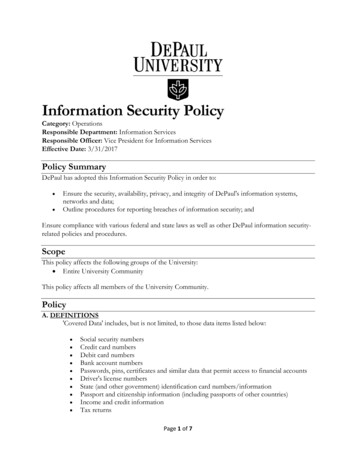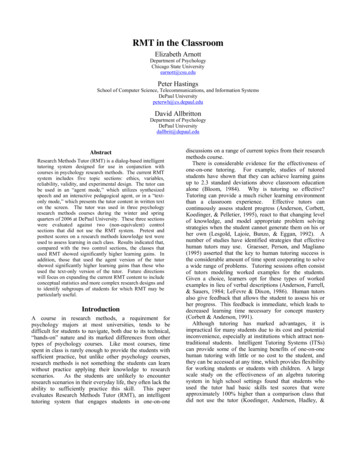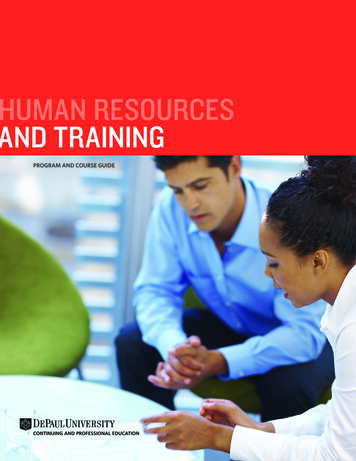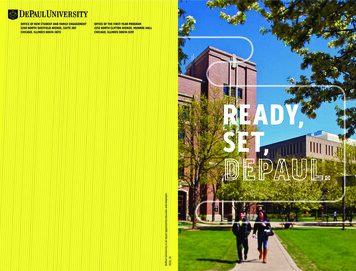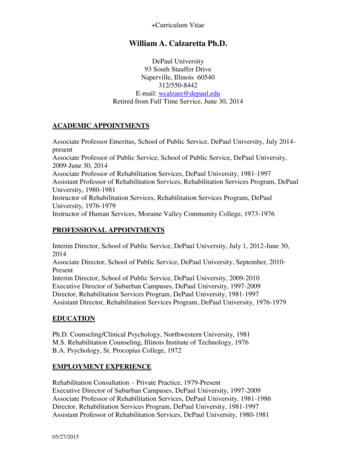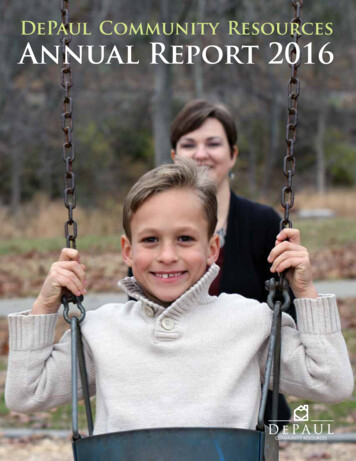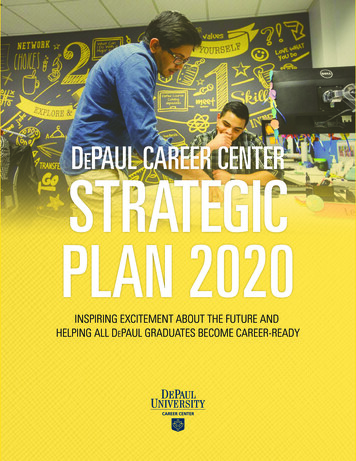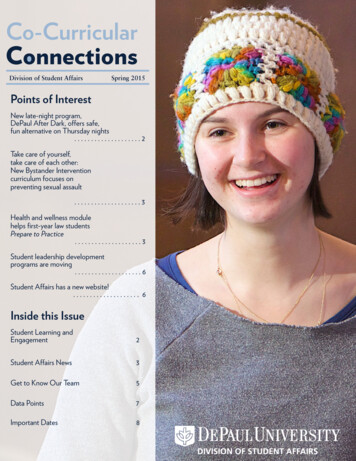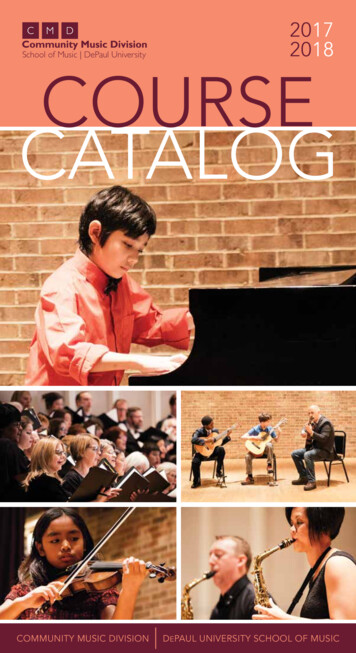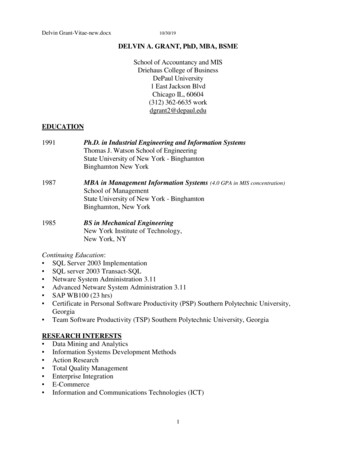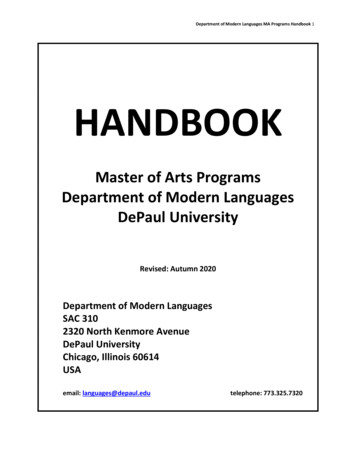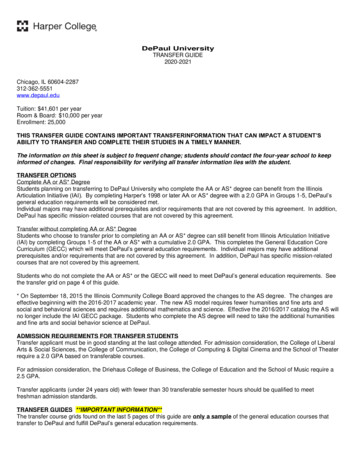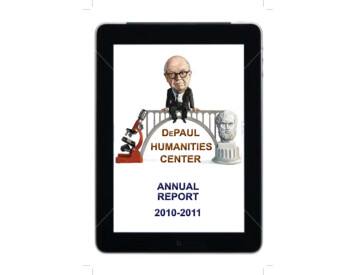
Transcription
CONTENTSDEPAUL HUMANITIES CENTER1FROM THE DIRECTOR22010-2011 SPEAKERS5FACULTY FELLOWS19JEFF CARTERDONALD L. OPITZALEX G. PAPADOPOULOSJOHN SHANAHANMARGARET STOREYEVENTS29FEATURE COMMENTARY31BY STEVEN E. JONESFROM THE NETWORK IS EVERTINGREGINALD GIBBONS37SLOW TRAINS OVERHEADCLASSICS IN CONTEXT38JOHN SHANAHAN ON RICHARD POWERSOn the Cover:Illustration of C. P. Snow by Matt CollinsReprinted with permission of artistDEPAUL POETRY INSTITUTEBRUTE NEIGHBORS39
DEPAUL HUMANITIES CENTERThe DePaul Humanities Center,founded in 1999, serves as asite for discussion and researchin the arts and humanities atDePaul University.Bringing together faculty,staff, students, scholars,community leaders, and artists,the Center engages ourcommunities in the mostrecent and impressivescholarship in the humanities.Central to the Center’scommunity engagement is theexchange of ideas acrossdisciplines, the communicationof interests through activeoutreach, and the chance tolearn from those outside ofthe academy.Humanities Center StaffDirectorJonathan Gross,Professor, EnglishAssociate DirectorAnna Vaughn Clissold, Ph.D.Center AssistantAlecia PersonStudent WorkerStefani ChowOur goals are to: Support and nourish humanitiesscholarship and teachingthroughout the university; Support interdisciplinary work inthe humanities; Increase public visibility of workin the humanities conducted byuniversity faculty, staff, andstudents; Initiate and encourage theconsideration of contemporaryproblems and solutions from thevantage point of humanisticthinking; Build and strengthen links withother institutions, communitygroups, and educators.Executive CommitteeGlen CarmanAssociate ProfessorModern LanguagesFrida FurmanProfessorReligious StudiesDarrell MooreAssociate ProfessorPhilosophyLucy RinehartAssociate Professor andDepartment Chair, EnglishEric SelingerAssociate ProfessorEnglishH. Peter SteevesProfessorPhilosophy1FROM THE DIRECTOROur theme at the Humanities Center this year was Literatureand Science. A series of lectures by Terry Eagleton, Anne Mellor, andNicholson Baker helped frame a discussion of the ways in whichscience and literature have come to co-exist, not always comfortably,in the academy. C.P. Snow ignited a fire storm when he firstsuggested that the education of a humanist and scientist werealmost incommensurable, challenging any literature professor toname Heisenberg’s second principle of thermodynamics. TerryEagleton explored the debate between Snow, an erstwhilenovelist and popularizer of scientific ideas, and F.R. Leavis, whoseGreat Tradition influenced a generation of literary critics. Anne Mellorfurther explored the tension between science and literature throughMary Shelley's Frankenstein, explaining how recent discoveries ingenetic engineering make Shelley's novel as relevant today as it was200 years ago. Her vivid account of Mary Wollstonecraft's death atthe hands of misguided doctors brought home, to students and facultyalike, the achievements and limitations of science. Nicholson Bakerdiscussed the technology of print by considering the readingexperience created by iPads and other handheld devices. His recentbook, Human Smoke, like Double Fold, explores the moralimplications of technological advances, showing how the destructionof newspapers (by microfilm) threatens to make the historical pastitself disappear.A highlight of this series was our round-table discussion of C.P.Snow’s The Two Cultures (1957). In attendance were a variety offaculty members from the College of Arts and Sciences (now theCollege of Arts and Social Sciences) including Michael Mezey(Political Science), Lynn Narasimhan (Mathematics), and Ted Anton(English). Attendance at our parallel lecture series, in DigitalHumanities, was also rewarding, as the audience listened to twodifferent viewpoints on the benefits of technology: Michele Rubin,of Writer’s House, explained the environmental downside of Apple,Google, and Kindle, while Steve Jones showed positive aspects ofthis brave new world, excerpts of which are included in this report.The outreach work of our five faculty fellows was particularlyimaginative and vigorous this year. The cohort (for lack of a prettierword) worked well together, offering informative and carefully2
prepared power point presentations, as well as drafts of forthcomingarticles and books. Seasoned teacher and scholar Margaret Storeyoffered a full-day seminar at the Newberry library, attended byChicago-area high school teachers, on the opposition to AbrahamLincoln in the North. Storey included items from the Newberry’scollection and surveyed, masterfully, the entire field of Civil Warhistoriography, with particular attention paid to Copperheads, byJennifer L. Weber. Storey is the author of a ground-breaking CivilWar study, Loyalty and Loss: Alabama Unionists in the Civil War andReconstruction. John Shanahan, an expert on 18th century dramaand science, discussed David Mitchell’s Cloud Atlas and other textsin his engaging research presentation at the Humanities Center. Hisoutreach work included a screening of Werner Herzog’s 2005 film,The Wild Blue Yonder, and the 1995 anime film Ghost in the Shell,with panelists June Chung and Miho Matsugu. The liaison with theMusic Box was our first and attracted many members of the Chicagocommunity.Alexander Papadopoulos gave a lecture to an appreciativeaudience of more than 60 people on Byzantine Cartography at theNational Hellenic Museum. He explored, in vivid detail, how little wereally know about the subject and how few material objects we haveupon which to base our conjectures. Jeff Carter’s sculpture exhibitionat the Illinois Institute for Technology’s famous Crown Hall was equallywell attended. He explored, through masterfully designed models, theaesthetic that informs IKEA, offering an ironic view of themass-consumed object even as he reaffirmed the value of Arts andCrafts through his own carefully worked models. His polished exhibit,attended by Paul Jaskot and other members of the Department ofHistory of Art and Architecture, was a resounding success, coveredin New City (among other publications). Donald Opitz, who has beenundertaking archival work at Windsor Castle and other locations,presented his work to top scholars in the field of Victorian scienceat Cambridge University, including noted Darwin biographer JamesMoore. He presented his research to DePaul faculty in a particularlyengaging way, which led to a fruitful discussion of Victorian scienceand subsequently to the launch of a 19th century studies group, led byJames Murphy, who was in attendance, along with Darrell Moore andElena Boeck .Continuing our efforts to reach DePaul students, we offereda one-day seminar on the Future of the Book, with archivist NanaHoltsnider, Diane Hoeveler, and Joseph Viscomi. The benefits ofdigital technology were on display with Nana’s presentation of theLeigh Hunt letters, showing how digital archives will continue to offerscholars readily accessible texts, even as bookstores close and the3economy continues to reel from the digital revolution. Hoeveler, whohas done extensive research on the Gothic novel, spoke about herrecent book, Gothic Riffs, and her forthcoming study that exploresrepresentations of Catholicism in gothic novels. Her innovativefocus on chap books promises to change the field of gothic studiesand shows the efforts of a lifetime dedicated to this important field. Anexcellent discussion between Miles Harvey and James Murphy ensuedafter Hoeveler's provocative lecture. Joseph Viscomi, creator of themasterful William Blake Archive, discussed Blake’s engravingtechniques and how recent scholars have misunderstood them.These humanities scholars have made the best use of old and newtechnology, combining traditional archival work at the Corvey Institutein Germany, for example--or the Tate Gallery in London--with digitalpresentation, enabling large numbers of people to read texts (withexpert scholarly commentary), to which they might not otherwise haveaccess. Thanks to Viscomi's important work, for example, studentscan now compare multiple editions of Blake's Songs of Innocence andExperience, no longer taking Walter Benjamin's word for it that thework of art has changed in the age of mechanical reproduction.2011 saw the publication of Brute Neighbors, a collection ofpoetry, prose, and essays edited by Chris Green and Liam Heneghan.Here too we saw the intersection of literature and science, ascontributors discussed Chicago in what would seem like anoxymoronic form, an urban nature anthology. Former DePaulHumanities Center fellow Dolores Wilbur contributed creative work, asdid former fellow Liam Heneghan and Visiting Fellow, Chris Green. Alaunch party for the book took place at the Lincoln Tap with readingsfrom the participants, and the Reader offered high praise for essays byMichele Morano ("Boy Meets World"), Miles Harvey (“17-Year Itch"),and other writers. Sally Berg and Mark Turcotte helped bring Chicagoauthor Reginald Gibbons (also a contributor to Brute Neighbors) toDePaul. Gibbons gave a reading from his most recent poetryanthology, Slow Trains Overhead, which was attended by more than 70people, including two creative writing classes.Our fellows’ programs would not succeed without the carefulreview of proposals by Glen Carman, Lucy Rinehart, and PeterSteeves, and we would like to thank them for their hard work. TheHumanities Center wishes to thank faculty members (Paula McQuade,John Shanahan, Dan Stolar, Ted Anton, June Chung, Randy Honold)who have gone out of their way to send classes to our lectures andincorporate our work into their syllabi.Sincerely,Jonathan GrossDirector, DePaul Humanities Center4
2010-2011 SPEAKERSTHE TWO CULTURES:SCIENCE AND LITERATURE REVISITEDIt happens that, of all novelists, Dostoevsky is the one I know thebest. When I was twenty, I thought The Brothers Karamazov was by along way the greatest novel ever written, and its author the mostmagnificent of novelists. Gradually, my enthusiasm became morequalified: as I grew older I found Tolstoy meaning more to me. ButDostoevsky is to this day one of the novelists I most admire: besidesTolstoy there seem to me only two or three others who can live in thesame light.This confession of personal taste is not so irrelevant as it seems. Ofthe great novelists Dostoevsky is the one whose social attitudes aremost explicitly revealed—not in his novels, where he is ambiguous, butin the Writer’s Diary which he published once a month during the years1876-80, when he was in his fifties and near the peak of his fame. Inthe Diary, which was produced as a single-handed effort, he gaveanswers to readers’ problems of the heart (the advice was almostalways practical and wise), but he devoted most of his space to politicalpropaganda, to passionate and increasingly unambiguous expressionof his own prescripts for action.They are pretty horrifying, even after ninety years. He was virulentlyanti-Semitic: he prayed for war: he was against any kind ofemancipation at any time; he was a fanatical supporter of the autocracyand an equally fanatical opponent of any improvement in the lives ofthe common people (on the grounds that they loved their suffering andwere ennobled by it).He was in fact the supreme reactionary: other writers since haveaspired to this condition, but no one has had his force of nature and hispsychological complexity. It is worth noting that he wasn’t speaking ina vacuum; this wasn’t like Lawrence banging away with exhortations,some of them similarly regrettable. Dostoevsky lived in a society; hisdiary was influential, and acted as the voice of ultra-conservatives, towhom he himself in secret acted as a kind of psychological adviser.The question is this: how far is it possible to share the hopes of thescientific revolution, the modest difficult hopes for other human lives,and at the same time participate without qualification in the kind ofliterature which has just been defined?—C.P. Snow56
TERRY EAGLETON, UNIVERSITY OF LANCASTERREFLECTIONS ON C.P. SNOW’S THE TWO CULTURES“The idea of culture has always been amatter of ferocious contention in themodern era, and has become even moreso in our own time. In the broadest sense,culture signifies forms of personal andsocial identity for which men and womenare prepared to do battle. Theconfrontation some decades ago betweenC.P. Snow and F.R. Leavis is a locusclassicus of this perennial debate, and thelecture will draw attention to the strengthsand limits of both of these notions ofculture, as well as to the diversity of theconcept as a whole. It will also examinesome of the ways in which the argumentover culture has shifted its terms sincethis classic confrontation, not least as thequarrel between the arts and sciences haspassed over into conflicts within thehumanities, in the shape of the so-calledculture wars.”Terry Eagleton is theDistinguished Professor ofEnglish Literature at theUniversity ofLancaster. Prior to hismove to Lancaster in2008, he was JohnEdward Taylor Professorof English Literature at theUniversity of Manchesterfrom 2001, and before thatThomas WartonProfessor of EnglishLiterature at the Universityof Oxford (1992-2001).His books include LiteraryTheory: AnIntroduction (1983); AfterTheory (2003) and TheIdea of Culture (2000). Heis also the author of thenovel Saints and Scholars(1987) and TheGatekeeper: A Memoir(2001). His latest booksare How to Read a Poem(2006); The Meaning ofLife (2007); Trouble withStrangers: A Study ofEthics (2008); Reason,Faith, and Revolution:Reflections on the GodDebate (2009) and OnEvil (2010).The two central cultures are discussedhere incidentally and are sometimes seen asculture versus civilization.Culture is spiritual, inward, transcendent,intense, profound; civilization is mannered,willingly material, sophisticated, progressive,rational, enlightened and I think in this debateSnow played civilization to Leavis’s culture.Snow is concerned about how to abolish worldhunger and practical political matters thatLeavis certainly isn’t, but he lacks any moralor scriptural depth. Leavis has that.—TerryEagletonEagleton converses withDePaul Professor Rocio Ferreira78
ANNE K. MELLOR, UCLAMOTHERING MONSTERS: MARY SHELLEY’S FRANKENSTEINAND GENETIC ENGINEERINGAnne K. Mellor isDistinguished Professorof English at UCLA, anda leading researcher inher field. In addition to herwork on MaryShelley, she is the authorof “Mothers of theNation: Women’sPolitical Writing, 17801800” (IUP, 2000)“Romanticism andGender” (Routledge,1993), and editor of“British Literature: 17801830” (Heinle, 2005).She has appeared as anexpert on Frankensteinon National Public Radio,the History Channel, ABCPrime Time, the SouthBank Show, and atnumerous venues inconjunction with theNational ScienceFoundation’s travelingexhibition onFrankenstein.9“Mary Shelley’s waking nightmare on June16, 1816, gave birth to one of the mostpowerful horror stories of Westerncivilization. Frankenstein can claim thestatus of a myth so profoundly resonant inits implications that it has become, at leastin its barest outline, a trope of everyday life.The condemners of genetically modifiedmeats and vegetables now refer to them as‘Frankenfoods,’ and the debatesconcerning the morality of cloning or stemcell engineering constantly invoke thecautionary example of Frankenstein’smonster. Nor is the monster-myth cited onlyin regard to the biological sciences; criticsof nuclear, chemical, and biologicalweapons alike often make use of thismonitory figure. Of course, both the mediaand the average person in the street havefrequently and mistakenly assigned thename of Frankenstein not to the maker ofthe monster but to his creature. But as weshall see, this ‘mistake’ actually derivesfrom a crucial intuition about therelationship between them. Frankenstein isour culture’s most penetrating literaryanalysis of the psychology of modern‘scientific’ man, of the dangers inherent inscientific research, and of the horrifying butpredictable consequences of anuncontrolled technological exploitation ofnature and the female.” This talk willelucidate both the scientific and thepsychological origins of Mary Shelley’smythic novel, as well as Shelley’s ownvision of the worst and best ways to copewith the creation of ‘monsters.’”I would like to suggest that implicit in Frankensteinthe novel is an alternative to Victor Frankenstein’sscientific project. Mary Shelley has a fundamentalmoral belief manifested in this novel, a belief thatcivilization can only be genuinely forwarded, thatprogress can only really occur, when we act incooperation with Mother Nature.Stem cell engineering, of course, is when abiologist genetically modifies a pre-fertilized egg inorder, usually, to eliminate hereditary diseases. Butalso, potentially, stem cell engineering could change apre-fertilized egg in order to produce eggs that would bereplanted in the womb to increase, first, humanintelligence, secondly, physical attractiveness andthirdly, emotional stability. You can make your not-yetborn child more intelligent, more attractive and moreemotionally stable. I would say this has all sorts ofFrankensteinian implications, and raises all the sameissues that the text of Frankenstein does.What Mary Shelley’s novel shows us is whathappens when we abandon or reject that which isunique. He becomes a monster. As he says in thenovel, “You are my maker, but I am your master. Obey.”A monster who is capable of destroying his maker. Butthe novel leaves open the question of what wouldhappen if we loved this creature.—AnneMellor10
NICHOLSON BAKERBRIDGINGS: FROM THE TWO CULTURES TO THEDIGITIZATION OF THE BOOKNicholson Baker was the final speaker inour lecture series, “The Two Cultures:Science and Humanities.” Whileconsidering the relationship betweenscience and the humanities with referenceto his work as a fiction writer, Baker alsosubstantially addressed the theme of oursecond series, “Digital Humanities,” withrespect to the digitization of the book. In1999, Baker established a non-profitcorporation, the American NewspaperRepository, to rescue old newspapers fromdestruction by libraries. Baker’sinfluential book, Double Fold (2002), grewout of this work and from a New Yorkeressay he wrote on the subject of whylibraries were destroying first editions ofbooks and newspapers.“Throughout his book, Baker hammersaway at the Orwellian notion that we mustdestroy books and newspapers in order,supposedly, to save them. Particularlysingled out for opprobrium are UniversityMicrofilms Inc. and the Library of Congress.This extremely well-written book is not aparanoid rant. Double Fold is the narrativeof a heroic struggle: Picture Baker as ‘OffisaPup’ defending ‘Krazy Kat,’ of the printedword, against the villainous ‘Ignatz Mouse’of the library establishment all in glorious,vivid color on brittle (but unbowed)newsprint. Highly recommended for alllibraries.”From Library JournalBarry Chad, Carnegie Library ofPittsburgh11Nicholson Baker is theauthor of several novels,including TheAnthologist (2010, afascinating exploration ofthe making of poetry anda poet’s undoing), TheFermata (2004), TheMezzanine (1998), andVox (a 1998 New YorkTimes best-seller), andfour works of nonfiction:The Size of Thoughts(1997), U and I (1998, (ameditation on JohnUpdike), Double Fold:Libraries and the Assaulton Paper (winner of the2002 National BookCritics Circle Award), andHuman Smoke: TheBeginnings of World WarII, the End ofCivilization (a 2008 NewYork Times best seller,Human Smoke is ahistory of World War IIthat questions thecommonly held belief thatthe Allies wanted to avoidthe war at all costs).Baker is one of the most beautiful, original andingenious prose stylists to have along in decades. Hehas some of his idol Updike’s visual acuity and some ofNabokov’s gift for metaphor, but he is funnier than eitherand takes a kind of mad scientist’s delight in the waythings work and how the world is put together. Here isthe narrator of Room Temperature describing his infantdaughter, whom he has nicknamed Bug:‘The Bug’s nostril had the innocent perfection of aCheerio (and Cheerios were on my mind, since lately wehad begun to offer them to her), a tiny dry clean salty ring,so small, with the odd but functional smallness of thetires on passenger planes, or the smooth rim around thepistil of the brass pump head that you fitted over a tire’sstem valve to inflate it to a pressure you preset with acrank on the air machine.’Years before David Foster Wallace popularized theextended digressive footnote, Baker stuffed Mezzaninewith dozens of small-type, bottom-of-the-pagemini-essays about doorknobs, staplers, plastic drinkingstraws and this one, about Jiffy Pop:‘Jiffy Pop was the finest example of the whole aluminousgenre: a package inspired by the fry pan whose handle isalso the hook it hangs from in the store, with a maelstromof swirled foil on the top that, subjected to the subversionof the exploding kernels, first by the direct collisions ofdiscrete corns and then in a general indirect uplift of thetotal volume of potentiated cellulose, gradually unfurls itsdome, turning slowly as it despirals itself, providing in itsgradual expansion a graspable, slow-motion version ofwhat each erumpant particle of corn is undergoinginvisibly and instantaneously beneath it.’— Charles McGrath, The New York Times Magazine, August 7, 201112
THE TWO CULTURES:SCIENCE AND LITERATURE REVISITED2010-2011 SPEAKERSDIGITAL HUMANITIESFOR FURTHER READINGBeer, Gillian. Open Fields: Science in Cultural Encounter. Oxford:Oxford University Press, 1999.MICHELE RUBIN, WRITER’S HOUSETHE FUTURE 0F THE BOOKElkins, James. Six Stories from the End of Representation: Imagesin Painting, Photography, Astronomy, Microscopy, ParticlePhysics, and Quantum Mechanics. Stanford: Stanford UniversityPress, 2008.Frayn, Michael. Copenhagen. New York: Samuel French, 2010.Leavis, F. R. The Two Cultures? The Significance of C.P. Snow.London: Spectator, Ltd., 1962.Levine, George. "One Culture: Science and Literature." In OneCulture: Essays in Science and Literature, edited by GeorgeLevine, 3-34. Madison: University of Wisconsin Press, 1987.Guillory, John. “The Sokal Affair and the History of Criticism.”Critical Inquiry 28.2, 2001.Herrnstein Smith, Barbara. Scandalous Knowledge: Science, Truth,and the Human. Durham, NC: Duke University Press, 2006.“In the last 10 years, digital technology haschanged the human landscape assignificantly as the Gutenberg Bible did inthe 15th century. It is swiftly evolving andgrowing and changing our culture in waysthat we cannot always see and withconsequences we cannot always unravel.The most profound and immediate impactis on the concept of the written word -- whatgets written, published, taught, remembered. Literary agent Michele Rubin willdiscuss some of these changes and theirimpact on the book and on the humanities.”Michele Rubin is aSenior Literary Agentat Writers House, oneof the largest and mostsuccessfulagencies in the world.She represents a rangeof writers, focusingmostly on non-fiction.She is also the LiteraryAgent for the Estate ofMartin Luther King, Jr,and was responsiblefor the creation of thenew King LegacySeries Imprint atBeacon Press.Latour, Bruno. Iconoclash: Beyond the Image Wars in Science,Religion and Art. Cambridge, MA: The MIT Press, 2002.Ortolano, Guy. The Two Cultures Controversy: Science, Literature,and Cultural Politics in Postwar Britain. Cambridge: CambridgeUniversity Press, 2009.Snow, C. P. The Two Cultures. Introduction by Stefan Collini.Cambridge: Cambridge University Press, 1998.Wilson, Edmund O. Consilience: The Unity of Knowledge. London:Vintage, 1999.1314
THE DIGITAL HUMANITIES IN CONVERSATIONA powerpoint presentation of imagesaccompanied the narrative, and abibliography of resources wasprovided toaudiencemembers.”NANA HOLTSNIDERUNIVERSITY OF CHICAGOTHE LEIGH HUNT LETTERSDIGITAL ARCHIVE AT IOWA“In today’s world of Google Books,Special Collections is where all ofthe unique content is. . . but there isa big problem of access. Idiscovered that there were thesegems hidden away that providedgreat insight into the RomanticCircle, and that people were missingout by not knowing that theseexisted. Since no publishedcomplete collected letters existedfor Leigh Hunt, this seemed like theperfect opportunity for Iowa to gostraight online.”Nana Holtsnider is a former RuthBywater Olson Fellow in SpecialCollections at the University ofIowa, and is currently a doctoralstudent in Comparative Literatureat the University of Chicago.HAUNTED ARCHIVES:RESEARCH IN DIGITALAND DUSTY PLACES15JOSEPH VISCOMIUNIVERSITY OF NORTH CAROLINABLAKE’S ENLIGHTENEDGRAPHICSDIANE HOEVELERMARQUETTE UNIVERSITY“This presentation traces onescholar’s journey to gather raregothic texts, novels, dramas, andchapbooks, in England, Germany,and the United States. Where atone time such a quest would havebeen almost impossible, it is nowmuch easier given the advancesthat have been made indisseminating information anddatabases, as well as allowing thedigitization of rare materials inspecial collections.Brontes (1998); and Gothic Riffs:Secularizing the Uncanny in theEuropean Imaginary, 1780-1850(2010). In addition to publishingsome 65 articles on a variety ofliterary topics, she co-authoredwith Lisa Jadwin a critical study ofCharlotte Bronte, and edited theHoughton Mifflin volume ofWuthering Heights.Diane Long Hoeveler is co-editorof European Romantic Reviewand Professor of English atMarquette University, where shespecializes in teaching courseson the Gothic, BritishRomanticism, and women’sliterature. She is author ofRomantic Androgyny: TheWomen Within (1990); GothicFeminism: TheProfessionalization of Genderfrom Charlotte Smith to theJoseph Viscomi is the James G.Kenan DistinguishedProfessor of English andComparative Literature at theUniversity of North Carolina atChapel Hill. He has receivedfellowships from the GuggenheimFoundation, National Endowmentfor the Humanities, NationalHumanities Center, and theRockefeller Foundation StudyCenter in Bellagio, Italy. He isthe co-editor, with Morris Eavesand Robert Essick, of WilliamBlake’s Illuminated Books,volumes 3 and 5 (1993), andco-editor/creator with Eaves andEssick of the William BlakeArchive blakearchive.org , ahypertext of Blake’s poetry andart, based on approximately 6000images transferred to digital form.“Blake’s Enlightened Graphics:Illuminated Books and NewTechnologies is a richly illustratedlecture examining William Blake’silluminated printing, the radicalprintmaking technique that heinvented in 1788 and used toproduce most of his illustratedbooks, the key facsimiletechnologies in the 19th and 20thcenturies used to reproduce them,and the digitaltechnology usedto reproduce themtoday in theWilliam Blake Archive blakearchive.org .”16
STEVEN E. JONES, LOYOLA UNIVERSITY CHICAGOTHE NETWORK IS EVERTING:THE DIGITAL WORLD AND THE HUMANITIES”As everyone knows, the world we livein is increasingly pervaded by digitalmedia, from e-books to social networksto video games. It’s widely feared thatdigital technology threatens to “take over”our time, attention, our very social being.Cultural anxieties about the metastasizingof the digital world are often based on theassumption that the digital is somehowinherently alien, inhuman, a separatematrix beyond the analog, thereal—beyond the world we live in,something transcendent and apocalyptic,an immaterial force that humanists,especially, are called to resist. But is thedigital a world apart? Or is it a part of theworld? How humanists understand andframe the nature of digitaltechnology today has a good deal to dowith the forms it will take in the future, andwith its broader cultural effects. Contraryto popular opinion (and the quiet culturepanic running beneath that opinion), todaythe digital realm—what used to be called“cyberspace”—is “everting” (as authorWilliam Gibson has said), turning itselfinside out and spilling out into the world.This offers profound opportunities—evenethical imperatives—for humanists,especially those willing to engage in theinterdisciplinary and worldly practices ofthe digital humanities.”17Steven E. Jones is theeditor of “TheSatiric Eye” and authorof “Satire andRomanticism,” as wellas “AgainstTechnology” and “TheMeaning of VideoGames,” and coauthorof the forthcoming“CodenameRevolution: TheNintendo Wii VideoGame Console.” Hisnewest book,“CodenameRevolution: theNintendo WiiVideogame Console,”if forthcoming from MITPress in 2012. Aleading researcher inhis field, he is theCo-Director of theCenter for TextualStudies and DigitalHumanities at Loyola.18
2010-2011FACULTY FELLOWSJEFF CARTERART, MEDIA AND DESIGNTHE COMMON CITIZENSHIP OF FORMSFor my Humanities Center project I constructed a series oflarge-scale architectural models using altered IKEA products such astables, desks, shelves and flooring. The models and theirarrangement are based on the eight buildings at the Michael ReeseHospital campus designed between 1947 and 1959 by WalterGropius, founder of the Bauhaus. In the past year, these buildingshave been destroyed by the City of Chicago (under the patently falsepretenses of preparing the 2016 Olympic Games), drawingworldwide outrage. My exhibition opened June 2, 2011, at Mies vander Rohe’s R.S. Crown Hall at the Illinois Institute of Technology,while the dust was still settling.I am especially thankful that the DePaul Humanities Centerrecognized the timeliness of this subject and was able to respondquickly to my proposal. This has been the most ambitious project Ihave yet undertaken, and the resources provided by the Center wereinvaluable. Further, the support of the Center enabled me tosuccessfully apply for an Illinois Arts Council Project grant, withwhich I will fund the publication of an exhibition catalog featuring twoscholarly essays on this project.June 13: Art Break: Bauhaus versus IKEA“I’ve been to IKEA ten, maybe twelve tim
The DePaul Humanities Center, founded in 1999, serves as a site for discussion and research in the arts and humanities at DePaul University. Bringing together faculty, staff, students, scholars, community leaders, and artists, the Center engages our communities in the most recent and impressive scholarship in the humanities. Central to the .
